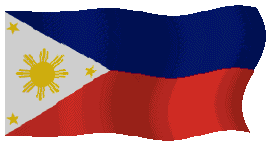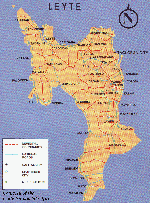
Last Updated:
11/10/98 08:17:24 AM
(MANILA TIME)
One of the oldest provinces in the country, Leyte is perhaps the most economically developed of the six provinces of the Eastern Visayas region. While the trend in Samar Island has long been the preservation of the traditional natural resource base, Leyte has been more open to the influx of heavy and medium industries such as geothermal plants, mineral processing and mining companies.
The province's two cities are the model for the rest of the region in terms of development. Tacloban City in the east is the regional capital and the biggest city in the region in terms of population and income. It is home to the regional offices of the national government agencies and is the center of commerce for most of region. The burgeoning city of Ormoc in the west is not far behind. Fueled by lucrative business ties with Metro Cebu (the nation's second largest metropolis next to Metro Manila) and home of the biggest industries in the region, Ormoc is fast becoming the investors choice in the region. It is interesting to note that Ormoc (a chartered city) is closer to Cebu culturally and ecomically than it is to Tacloban City. In addition to these cities are 49 towns broken down into 1,642 barangays (the smallest political unit in the Philippines) with a population of 1,635,156 (1995 census). During the turn of the decade, Leyte had the seventh largest population in the country which was more than half of the entire region. Population growth is placed at 1.26 percent annually. Leyte is the only province in the region which has two main dialects: Waray and Cebuano. Generally, people on the western part of the island are Cebuanos both in language and culture while those on the east are Warays. Pilipino (the national language) and English however are spoken and well understood by an overwhelming majority of the populace.
A long, rough mountain range bisects the province from north to south. To the east and west of this range are gentle rolling hills and vast, productive plains stretching to the sea. Leyte is the rice granary of the region producing more than half of the rice output of the entire Eastern Visayas.
The province is the center of transportation and telecommunication in the region with the only functional airport remaining in this part of the country located in Tacloban City. Leyte boasts of the best road network in the region with most of its 49 towns easily accessible by regular buses and other modes of land transportation. Tacloban's bus terminal is the hub of public land transportation in Eastern Visayas with buses and jeepneys plying regular routes to and from several points in the other five provinces and even to Mindanao and Manila. (If you don't know what a "jeepney" is, then visit the links page. It's a very "pinoy" concept and could be explained better by other pinoy web sites!)
Communication facilities in Leyte have vastly improved since the start of the decade. Direct national and international connections are now readily available especially in the more progressive towns and cities. Internet Service Providers have been enjoying brisk business and more and more households in the province are going online. Internet cafes have cropped up like mushrooms in Tacloban and Ormoc one of which is rumored to be starting a 24-hour, 7-day a week service soon. Telephone connections are above average than the rest of the country with newly installed optic fiber lines and routers. Cell sites have been expanding for the last two years.
Leyte is known as the geothermal capital of the Philippines with its geothermal plants with a potential generating capacity of some 2,000 megawatts (actual generating capacity as of last year was 112.5 megawatts) supplying electricity not only to the entire region but neighboring Cebu and even the island of Luzon to the north.
The province is a showcase of rich history set in an unspoilt setting. Testaments to this rich heritage, such as vestiges of the Spanish colonial era (early 1500s to early 19th century) still dot the land.Well-preserved homes and buildings dating back to the era still line centuries-old streets. Leyte also became prominent during World War II after the biggest naval battle in human history in terms of the number of ships engaged was fought off its coast on October 21, 1944. The island became the entry point of the Allies in taking back the country from the Japanese.
For more information on Leyte province, visit the links section.
